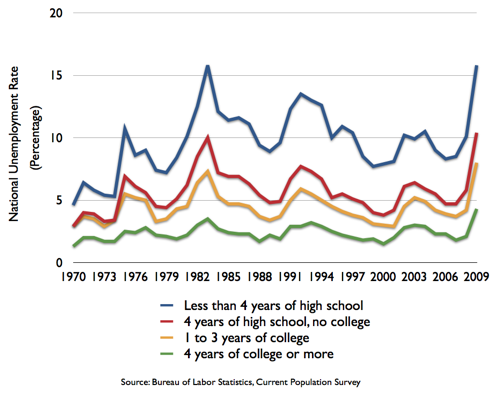Despite the tremendous benefits of information technology (IT), it comes at a human cost — the displacement of less-skilled employees.
As software and systems automate an increasingly large portion of business processes, the displacement is affecting a wider set of workers. Machines are becoming more and more capable of performing many human jobs cheaper and more efficiently, which spells danger for the labor market.
So despite an improving economy, 9.5 percent national unemployment might last longer than many think.
The data tells a compelling story. The safe havens in the labor market for the foreseeable future appear to lie in the realms of technical skills and advanced education.
 IT spending has steadily risen since 1970, as shown by this chart. Current trends and new opportunities like cloud computing suggest that the current dip in spending is only temporary.
IT spending has steadily risen since 1970, as shown by this chart. Current trends and new opportunities like cloud computing suggest that the current dip in spending is only temporary.
These technology investments have increased productivity; labor output per hour has been steadily rising over the past 40 years, along with the IT spending.
This faster, cheaper output is often performed by machines – so the humans who have historically done the same jobs are facing diminished employment prospects.
The resulting productivity has been great for business, leading to higher profits. But these profits don’t benefit everyone. They accrue to the executives and shareholders while the low-ranking employees face new weaknesses in job security.
IT is slowly replacing many functions, and the best response is to obtain more sophisticated skills. There’s an ever-widening divide in the labor market between skilled occupations and what one might call “low-level jobs” – simple clerical roles, plant-floor jobs, and low-level support roles. The chart below depicts the differences in unemployment rates between different education levels.
This polarization between highly-skilled and less-skilled workers is part of what’s eroding the middle class, pushing more and more people into the low income bracket and shifting collective wealth toward the highest earners.
The less-educated workers who manage to keep their jobs are falling further and further behind in the national income distribution as the relative value of their services declines. One industry that shows promise for future growth and investment, however, is technology.
The Tech Pulse Index, shown below, tracks the growth of national economic activity in technology by combining data on employment, investment, production, shipments, and consumption. The Tech Pulse Index has risen sharply (with the exception of the dot-com bust around the year 2000), reflecting continued demand for high-tech workers.
 The same is true in other engineering disciplines, health care and finance. So how can you avoid being replaced by a machine? You’ll need to work in one of these advanced fields that still requires highly-skilled human capital.
The same is true in other engineering disciplines, health care and finance. So how can you avoid being replaced by a machine? You’ll need to work in one of these advanced fields that still requires highly-skilled human capital.
IT is good for society in the long term, but it’s a double-edged sword when considered together with labor market trends. Sure, the current economic despair owes its severity to many different issues — offshoring of jobs, the real estate collapse, and the national debt are just a few — but education and income disparities are long-term problems that demand attention.
We must align education growth with productivity growth to close the gaps.
This guest post by Hunter Richards, a blogger for Software Advice, was originally published on his Software Advice blog.
